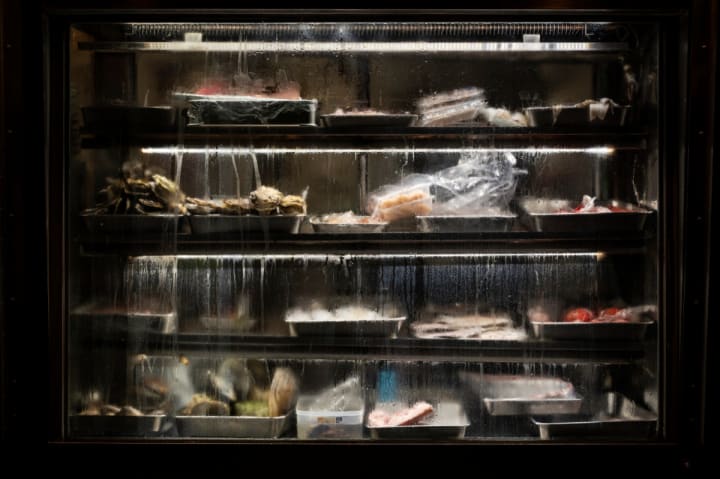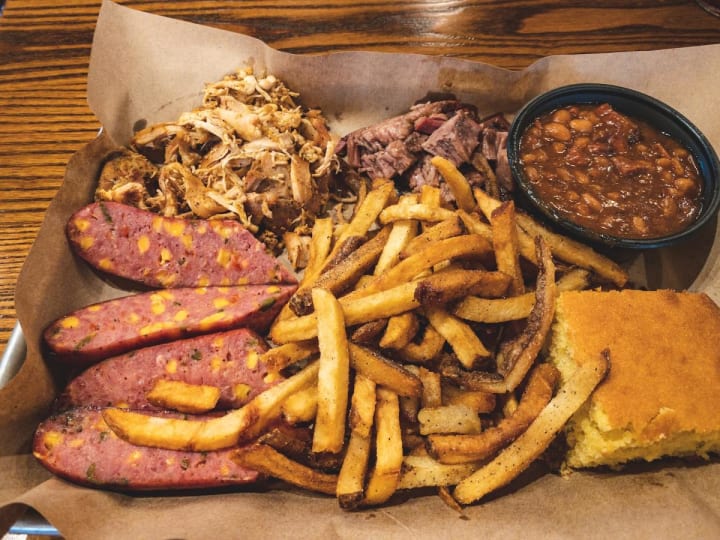The History of the Most Iconic TV Dinners!
Yes, some of them did have flavorful qualities. I'm in luck. My partner watches Swanson turkey dinners on television. Make your better half prosperous as well. However, the disrupted end of microwaveable meals just outperforms the terrible history that we currently know about it.

Why don't we do away with the aluminum foil top right now and get some deliciously crunchy corners instead?
Here is the background information regarding televised feasts. Almost ten years earlier, in 1944, everything began. Years before, when he overplanted cauliflower on his land, successful New York creator William L. Maxson had the concept for packaging a complete frozen supper. And who hasn't run into that problem before?
He cooked more cauliflower, placed it in the cooler, and then quickly forgot about it after arranging it. It is cauliflower, which isn't really worth anything.
One single dish of meat and vegetables is divided and placed on a paper plate that is round, divided, shining, and roughly 12 inches wide. In any event, he didn't plan these dinners in advance taking into account the entire populace. Maxson introduced his product to the market. For his spic and span, earth-shattering frozen feasts, Maxson traveled to the Naval forces.
Small, affordable snacks were a great idea, according to naval force officials, given how expensive plane transporters are.
Instead of the usual canned secret meat, packed grain, bread rolls, and cigarettes, the men on board the Maritime Air Transport Administration flight would now receive heated feasts with food that looked, smelt, and tasted amazing. Additionally, just in time for the Second Great War. These pre-prepared frozen meals included a main dish, such as steak, meatloaf, stew, corned beef, steak, hash ham, or breaded veal cutlets, as well as two servings of hot bread or vegetables.
These meals referred to as Maxson Sky Plates, were heated using the Maxson Hurricane Broiler, a type of convection cooker.
That upgrade is fantastic.

Who could purchase those stoves?
Maxson entered into a specific concurrence with Container American Aviation routes to provide the exact same frozen military dinners to homegrown explorers in standard citizen bundling. Once word of his remarkable invention reached the general populace, it was only a matter of time before people needed to use Sky Plates at home.
In this way, Maxson renamed Sky Plate as the Strato-Dinner in September 1946, one year after the end of the Second World War, ostensibly because it would elevate your taste buds.
As a result of the GI Bill, which made it possible for returning Second Great War veterans to purchase homes, they had the choice to abandon their jobs and start families in suburbia.
Furthermore, Maxson's Strato-Feasts were specifically designed for housewives juggling childcare and domestic duties while their husbands were away working in the city. It was advertised as a complete feast that required no preparation or cleanup afterward. Everything in the rubbish is thrown out, which is entertaining in and of itself. Dishtossing is far more entertaining than dishwashing.
As frozen dinners became more common, other, smaller frozen food companies also tried their hand at them. When Quaker States Food variations arrived on the market in 1952 and introduced its lightweight aluminum plate with a slight aluminum cover, the situation had already been successfully enjoyed by Maxson for six years as the only option available in stores.
Other small territorial organizations quickly entered the frozen food competition, such as Frigidinner, who increased their frozen supper selection to include chicken chow mein with egg rolls and seared rice, veal goulash with potato lumps and peas and beef stew with peas and corn niblets.
Who Doesn't Enjoy a Delicious Reheated Goulash?
Although frozen meals were rapidly advancing in inventiveness, they were still regarded as anomalies. Maxson, Quaker State Food sources, and Frigidinner did not experience a significant income decline, but they also did not experience a significant income increase.
That is, up to September 10, 1953. On September 10, 1953, Swanson, a well-known and dependable brand at the time, introduced their own frozen prepared meal. Do not spook my better half. She receives Swanson television turkey feasts from the cooler of our refrigerator when I'm somewhat late. There were two or three different turkey cuts, cornbread dressing, peas, and yams.
According to family lore, the Swanson company came up with the concept for a pre-packaged frozen meal when they realized they had 520,000 pounds of leftover turkey from Thanksgiving the previous year that hadn't been sold.
The 520,000 pounds of frozen turkey pieces allegedly were loaded onto cold train cars to cause a delay while the Swanson siblings looked for a way to dispose of all that turkey. As this train of turkeys traveled throughout America, the Swanson Company tried to come up with suggestions for the best way to save those bird pieces. Additionally, either Gilbert, Clarke Swanson, or Gerry Thomas, a top sales representative for Swanson, had the concept. That is correct; not even Swanson has the power to dispel the myth about their microwaveable dinners.
He developed the idea for the frozen prepared feast after returning from a work trip and receiving a warmed full dinner on a disposable trisection dish. If you haven't put everything together already, I'll do it for you. Thomas was receiving Maxson's Strato-Feast, which had been available for a while, while on a Skillet American excursion.
With that in mind, Swanson decided to use its frozen turkeys to assemble a ready-to-eat turkey dinner on an aluminum plate, which its customers could then reheat, eat, and discard. The topic has been under discussion for a while, and it has only gotten murkier.
Who invented the first frozen packaged meal?
In interviews, former Swanson salespeople and family members who were present at the time affirmed that Gilbert and Clarke Swanson, not Thomas, were the ones who came up with the proposal. In reality, none of the gatherings did, though. Swanson Company combined the Maxson arrangement and all-aluminum plate from Quaker States Food variety and then bundled it in lovely packaging.
The key factor in people adopting the Swanson guarantee was that Swanson was a lavish company with a well-known brand and substantial marketing resources.

The Swanson siblings did not produce frozen-pressed meals; instead, Gerry Thompson is thought to have contributed to their commercial success. He gave it a name. Gerald Thomas' original story about the trains and the frozen leftover turkey pieces has been proven false throughout time since the middle of the 1950s. Despite this, the facts clearly show that Thomas is credited with coming up with the name for Swanson's frozen dinners. He suggested they were "television feasts."
No one is aware of the originator of the television meal, despite Thomas' claim that he came up with the idea after observing how widespread it had become. Plugs and newspaper advertisements started to include the television plate. We only know that television plates existed because after World War II, a wave of home TV agreements allowed America to loosen its assembly ban and build additional TVs. Nothing is more American than dining while watching TV.
Obviously, Thomas received assistance with the marking. M. Crawford Pollock, a pioneer in Swanson's internal promotion, had the idea to make the Microwaveable meal's external bundle resemble a TV. Swanson just sold 5,000 copies of his most enduring Thanksgiving-themed turkey television feast, which cost $0.98. 1954 was the first full year of production, but the next year they sold an astounding 10 million plates.
The following year, they offered 25 million. In this way, a foundation for the United States was set up. The Swanson siblings' microwaveable dinners completely destroyed more minor territorial companies like Maxson, Quaker State Food Sources, and Frigidinner because they had the money and name recognition. giblet sauce and sliced turkey!
How ground-breaking is that?
In 1960, Campbell's Soup included a pastry plate as the fourth component of its plate. A brownie, apple shoemaker, or cherry pie was frequently offered. This is the greatest invention in modern times.
In 1969, they began offering breakfast, which consisted of hotcakes, fried eggs, wiener, bacon, and home fries on a Microwaveable meal plate.
They soon began referring to their early-morning meals as Extraordinary Beginnings and started including breakfast sandwiches with eggs and bacon.
In the 1980s, a variety of competitors, including Meal, Morton, and Libbyland, competed for the extra supermarket rack space. Salisbury steak, chicken, and turkey. In general, quite good. Le Menu had been introduced about that time, though, and Campbell had taken over the market. For the slow person with refined tastes, Le Menu Microwavable Meals offered a brilliant microwaveable plate with additional complex and sophisticated delicacies.
Dishes like turkey scalloping with garlic parmesan, prepared chicken, chicken bosom Florentine with Savoy spinach, and pepper steak with rice pilaf The advertised upscale freezer dinners included Duchess potatoes. Since I have no idea what even 50% of those things mean, it should be fantastic.
By the 1990s, consumers were starting to eat better, and companies that prepare frozen dinners, like Stouffer's, began to focus on the diet food market with their Lean Cooking line of meals with fewer calories.
Campbell's offered the Swanson television supper to Vlasic Food Variety Worldwide because the company was unable to capitalize on the wellness trend.
All of this happened at the point when Zenith Food Sources acquired Vlasic in 2001; at that point, it stopped referring to its frozen meals as Swanson Microwavable Meals and started calling them Eager Man dishes. After a product assessment in 2017, the Auntie Jemima brand was discontinued, and Auntie Jemima replaced the Incomparable Beginnings breakfast line.
Finally, The Eager Man microwaveable meal is now all that is available, and it is owned by a company by the name of Conagra Brands. The company's annual production of $9 million is not bad for frozen food. Of course, it falls short when compared to displays like Mean Joe Greene ripping off cooler doors or Steve Garvey and Tommy Lasorda chowing down on double hamburgers during a game in the Dodgers Arena tunnel.
About the Creator
Ahamed Thousif
🌟 Welcome to the realm of exploration, where communities come alive through the power of words! 📚✨ Join me as we embark on a journey to discover the vibrant tapestry of stories and Poems.
VISIT - "MY FOOD BLOG"






Comments
There are no comments for this story
Be the first to respond and start the conversation.